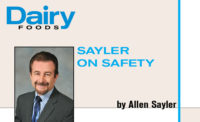The U.S. dairy industry has utilized traditional heat-based pasteurization to make raw milk safe for more than 70 years. While these systems completely inactivate harmful bacteria in raw milk, some believe the nutritional value and flavor of milk is affected.
Regardless of your view, today there are viable alternatives to heat-based pasteurization. The characteristics and value of each alternative is explored below. The Food and Drug Administration has stated that any alternative that can achieve a 5-log reduction of the most resistant bacteria in a measurable and reliable way could be used, once approved. Some of these technologies are being used in other countries.
Non-thermal pulsed electric field (PEF) utilizes a high-voltage power supply, a pulse modulator and a “switch” to turn on and off the voltage to the electrodes rapidly, repeatedly and reliably. This technology has been evaluated by private dairy companies as well as by the U.S. government and governments of other nations.
The outcome of a European two-year study found lower heating of the milk stream and preservation of the milkfat, milk proteins, enzymatic activity, pH, lower viscosity and smoother texture for yogurt. PEF also inactivates phosphatase. It is likely that the FDA would require strict monitoring of the critical factors (milk temperature, flow speed through the reaction chamber and cleaning). Start-up costs can be high.
High-pressure (hydrostatic) or “cold pasteurization” is used by the U.S. food industry for batch-processing many foods. This process requires a high-pressure chamber, a pressure source, a temperature control device and a material handling system. It inactivates harmful bacteria, yeast and mold as well as enzymes but not spores.
There is little impact on taste, color and the nutritional value of the food. The high pressure generally has a negative effect on whey protein, complex carbohydrates and lactose but no noticeable impact on milkfat and casein protein. Treatments range from 58,000 pounds per square inch for 15 minutes to 72,500 pounds per square inch for three minutes. It is likely that the FDA would require strict monitoring of the critical factors (time and pressure). Start-up costs can be high.
Thin-film UV light treatment is used and accepted by the FDA for clear liquids and juice beverages without significant turbidity. Listeria monocytogenes is the most UV-resistant pathogen while Staphylococcus aureus is the least. The process is accepted for milk in some countries.
There are reports of a slight lowering of milkfat and milk protein levels at higher UV intensities. It is likely that the FDA would expect monitoring of critical factors (UV bulb intensity and functionality, and flow rate through the reaction chambers). Start-up capital should be lower than most other alternatives listed.
Ultrasonication (manothermosonication, or MTS) usually is used with some heating of the milk (130F or higher). In laboratory studies, the use of a 20 kH probe on heated milk resulted in a 5-log reduction in Listeria monocytogenes and total bacterial count after 18 minutes. This is a potentially promising technology, but more research appears needed. MTS may be useful with other technologies.
Microwaves (electromagnetic waves) allow a more rapid heating than traditional surface heat exchangers. But the challenge is the non-uniform heating over the “body” of the milk. Current research is ongoing by universities and U.S. government agencies, including a look at variable frequency microwave heating and phase-control microwave processing.
Centrifugation uses a separator-like device. Since there are components of milk that could interfere with the use of centrifuges to remove food-borne bacteria, a combination of separation for milkfat removal and multiple centrifuges may be needed. It is likely that the FDA would require monitoring of the critical factors (feed rate into the centrifuges and the speed of the centrifuges). Centrifuge costs can be capital intensive.
Filtration (micro-, ultra- and nano-) is commonly used for cheese and whey processing and can theoretically filter out bacteria. The smallest harmful bacteria are approximately 1 µm in size so the pore sizes in ultrafiltration (0.01 µm to 0.1 µm) and nanofiltration (0.001 µm to 0.01 µm) should be able to remove harmful cells. However, the harmful bacteria would be in the retentate, the portion of the milk to be used. The FDA would likely require industry monitoring of critical factors (membrane pore size and stability, and membrane pressure and stability).
Note: I have not included ionizing radiation because it produces off-flavors in the milk.
In summary, of the seven technologies listed, the first four are options that should be explored further by the dairy industry as they may be preferable to the traditional heat-based pasteurization systems. These technologies could unlock significant technological advances for the dairy processing industry and expand marketing opportunities.
For additional information on alternative technologies to traditional heat-based pasteurization systems, contact me at asayler@cfsrs.com. Review other informational and training information on the CFSRS website: www.cfsrs.com



